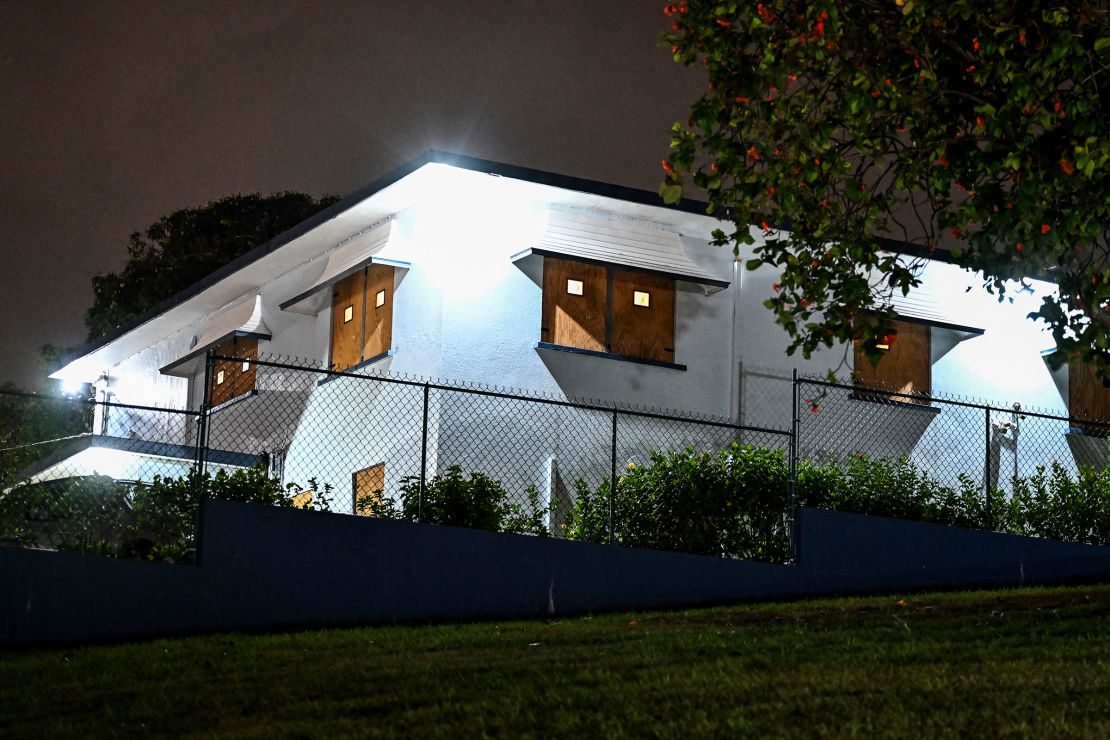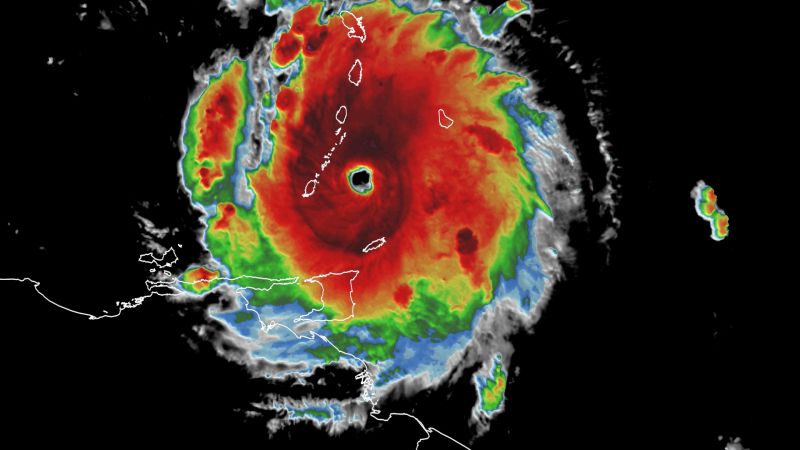CNN
—
[Breaking news update]
Beryl, the first hurricane of the 2024 Atlantic season, made landfall Monday morning on the Grenadines’ Carriacou Island in the Caribbean Sea as an extremely dangerous Category 4 with maximum sustained winds of 150 mph. It is the strongest known hurricane to pass through this region.
This story will be updated.
[Original story]
Hurricane Beryl strengthened again Monday morning into a Category 4 as it roars through the Windward Islands – the strongest storm there in two decades – endangering several island communities with life-threatening storm surge, violent winds and flash flooding.
The hurricane’s wrath stretched from Trinidad and Tobago north through St. Lucia and into Martinique as its center barreled toward the region Monday morning. Grenada and the Grenadines are most at risk of being struck by the core of the storm.
The hurricane’s powerful winds and torrential rain triggered power outages, flooded streets and ushered in storm surge flooding for parts of the Grenadines, Grenada, Barbados and Tobago Monday, according to the National Hurricane Center.
Beryl’s arrival marks an exceptionally early start to the Atlantic hurricane season. On Sunday it became the earliest Category 4 on record in the Atlantic Ocean and the only Category 4 in the month of June. The bathtub-warm ocean waters that facilitated Beryl’s alarming strengthening are a clear indicator that this hurricane season will be far from normal in a world warming due to fossil fuel pollution.
Beryl is breaking records for June because the ocean is as warm now as it would normally be at the peak of hurricane season, said Jim Kossin, a hurricane expert and science advisor at nonprofit First Street Foundation.
“Hurricanes don’t know what month it is, they only know what their ambient environment is,” Kossin told CNN. “Beryl is breaking records for the month of June because Beryl thinks it’s September.”
Kossin added the ocean heat fueling Beryl’s unprecedented strengthening “certainly have a human fingerprint on them.”
The storm briefly weakened to Category 3 status early Monday while undergoing an eyewall replacement cycle, a process in which the strongest hurricanes can shed an eyewall – the ring of most intense winds that surrounds the hurricane’s calm eye – as it builds a larger one. The hurricane weakens during this process but ultimately emerges as a more powerful storm.
Islanders were scrambling to finish final emergency preparations Sunday night even as tropical storm-force winds approached. Local officials are warning of potentially catastrophic impacts, including damage to homes, widespread power outages and threats to residents’ safety.
“I want everybody in Saint Vincent and the Grenadines to take this matter very seriously,” Prime Minister Ralph Gonsalves said. “There are some persons who are hoping for the best, and we must all do that, but we all have to prepare for the worst.”
Grantley Adams International Airport on Barbados reported sustained winds of 40 to 45 mph with a gust of nearly 70 mph Monday morning.
• Beryl is a dangerous hurricane: The storm is about 15 miles east-southeast of Carriacou Island, which is part of Grenada, has sustained winds of 140 mph and is moving to the west-northwest at 20 mph. Beryl’s hurricane-force winds extend 40 miles from center while tropical-storm-force winds extend about 125 miles.
• Life-threatening storm surge and flooding: The National Hurricane Center warned that “life-threatening storm surge will raise water levels by as much as 6 to 9 feet above normal tide levels” if Beryl makes landfall. Towering waves could also create life-threatening surf and rip currents and threaten small vessels and fishermen. Flash flooding is also a concern in parts of the Windward Islands and Barbados, where rainfall of 3 to 6 inches is expected through Monday – and up to 10 inches are possible in a few locations, especially in the Grenadines and Grenada. Barbados Prime Minister Mia Amor Mottley warned citizens to be “extremely vigilant.”
• Hurricane warnings: Barbados, St. Vincent and the Grenadine Islands, Grenada and Tobado. A hurricane watch is in effect for Jamaica. Tropical storm warnings are in effect for Martinique, Trinidad and St. Lucia. Tropical storm watches are in effect for the south coast of Dominican Republic from Punta Palenque westward to the border with Haiti, and the south coast of Haiti from the border with the Dominican Republic to Anse-d’Hainault.
• Hundreds evacuated: More than 400 people were being housed in hurricane shelters across Barbados on Sunday night, the nation’s Chief Shelter Warden, Ramona Archer-Bradshaw, told CNN affiliate CBC News. “I am pleased that people are using the shelters, if they are not comfortable at their homes, it is best to go to a shelter,” she said.

• State of emergency in Grenada: A state of emergency was declared by Grenadian Governor General Cecile La Grenade which will remain in effect from Sunday night to Tuesday morning. All businesses will must close except the police force, hospitals, prisons, waste disposal and ports.
• Airports closed: Airports in Barbados, Grenada and Saint Lucia were closed Sunday night as Beryl approached. Grenada’s Maurice Bishop International Airport is expected to reopen Tuesday morning, a spokesperson said. The Grantley Adams International Airport in Barbados and St. Lucia’s Hewanorra International and George Charles airports have also halted operations.
• Cricket World Cup fans stuck: Barbados is still hosting cricket fans from around the globe who traveled to the island for the T20 World Cup, some of whom will not be able to evacuate before Beryl arrives. “Our visitors are here with us,” said Barbados Prime Minister Mia Amor Mottley. “Some of them are not due to leave until Monday and Tuesday, and some of them have never gone through a hurricane or a storm before.” She implored residents to provide support for visitors, if possible.

This season is already off to a busy start as a second storm – Tropical Storm Chris – made landfall near Tuxpan, Mexico, off the Gulf Coast early Monday.
Beryl is ushering in a troubling start to a hurricane season that forecasters have warned will be hyperactive – and Beryl’s record-shattering activity may be a sign of what’s to come.
Beryl is the earliest major hurricane – defined as one that is Category 3 or higher – in the Atlantic in 58 years. The storm’s rapid intensification is very atypical this early into hurricane season, according to National Hurricane Center Director Mike Brennan. It’s rare for tropical systems to form in the central Atlantic east of the Lesser Antilles in June, particularly strong ones, as only a handful of tropical systems have done so, according to NOAA records.
The storm isn’t just early for this season. It is now the Atlantic Ocean’s third-earliest major hurricane. The earliest was Hurricane Alma on June 8, 1966, followed by Hurricane Audrey, which reached major hurricane status on June 27, 1957.
Beryl has also set the record for the easternmost hurricane to form in the Tropical Atlantic in June, beating a previous record set in 1933.
The central and eastern Atlantic traditionally become more active in August, in part because ocean temperatures have had time to warm and fuel developing systems.
This year, however, the Atlantic basin has seen above normal water temperatures and a lack of wind shear due to the transition from El Niño season to La Niña season, both of which are fuel for tropical development.
“Beryl has found an environment with very warm ocean waters for this time of year,” Brennan said.
Systems forming this early in the summer in this part of the Atlantic is a sign of the hyperactive hurricane season to come, according to research from Phil Klotzbach, a hurricane expert and research scientist at Colorado State University. Normally, ocean temperatures aren’t warm enough in June and July to help tropical systems thrive.
National Weather Service forecasters predict 17 to 25 named storms this season, with as many as 13 of those becoming hurricanes.
“That’s well above average,” Brennan noted.
CNN’s Monica Garrett, Gene Norman, Michael Rios, Marlon Sorto, Sandi Sidhu, Melissa Alonso, Isaac Yee, Eric Zerkel, Mary Gilbert, Rachel Ramirez and Brandon Miller contributed to this report.
#Hurricane #Beryl #lashes #islands #lifethreatening #Category #dangerous #early #start #season,
#Hurricane #Beryl #lashes #islands #lifethreatening #Category #dangerous #early #start #season
